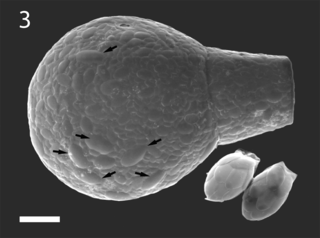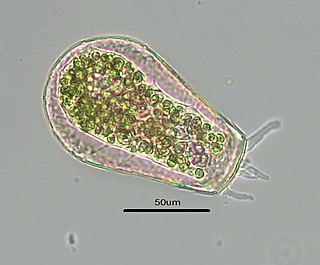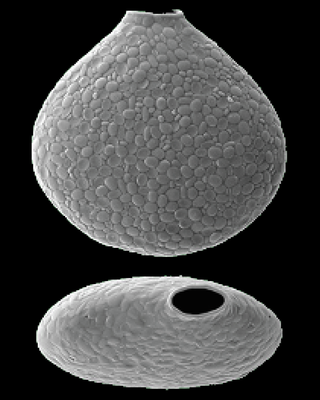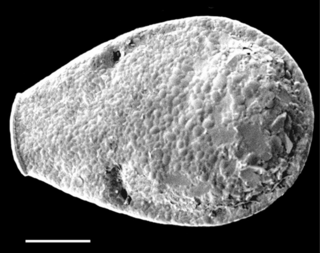
Amoebozoa is a major taxonomic group containing about 2,400 described species of amoeboid protists, often possessing blunt, fingerlike, lobose pseudopods and tubular mitochondrial cristae. In traditional classification schemes, Amoebozoa is usually ranked as a phylum within either the kingdom Protista or the kingdom Protozoa. In the classification favored by the International Society of Protistologists, it is retained as an unranked "supergroup" within Eukaryota. Molecular genetic analysis supports Amoebozoa as a monophyletic clade. Modern studies of eukaryotic phylogenetic trees identify it as the sister group to Opisthokonta, another major clade which contains both fungi and animals as well as several other clades comprising some 300 species of unicellular eukaryotes. Amoebozoa and Opisthokonta are sometimes grouped together in a high-level taxon, variously named Unikonta, Amorphea or Opimoda.

Lobosa is a taxonomic group of amoebae in the phylum Amoebozoa. Most lobosans possess broad, bluntly rounded pseudopods, although one genus in the group, the recently discovered Sapocribrum, has slender and threadlike (filose) pseudopodia. In current classification schemes, Lobosa is a subphylum, composed mainly of amoebae that have lobose pseudopods but lack cilia or flagella.

The Amoebidae are a family of Amoebozoa, including naked amoebae that produce multiple pseudopodia of indeterminate length. These are roughly cylindrical with granular endoplasm and no subpseudopodia, as found in other members of the class Tubulinea. During locomotion one pseudopod typically becomes dominant and the others are retracted as the body flows into it. In some cases the cell moves by "walking", with relatively permanent pseudopodia serving as limbs.

Difflugia is the largest genus of Arcellinida, one of several groups of Tubulinea within the eukaryote supergroup Amoebozoa. Arcellinida species produce shells or tests from mineral particles or biogeonic elements and are thus commonly referred to as testate amoebae or shelled amoebae. Difflugia are particularly common in marshes and other freshwater habitats.

Discosea is a class of Amoebozoa, consisting of naked amoebae with a flattened, discoid body shape. Members of the group do not produce tubular or subcylindrical pseudopodia, like amoebae of the class Tubulinea. When a discosean is in motion, a transparent layer called hyaloplasm forms at the leading edge of the cell. In some discoseans, short "subpseudopodia" may be extended from this hyaloplasm, but the granular contents of the cell do not flow into these, as in true pseudopodia. Discosean amoebae lack hard shells, but some, like Cochliopodium and Korotnevella secrete intricate organic scales which may cover the upper (dorsal) surface of the cell. No species have flagella or flagellated stages of life.

Arcellinid testate amoebae or Arcellinida, Arcellacean or lobose testate amoebae are single-celled protists partially enclosed in a simple test (shell).

Rhizamoeba is a small genus of free-living marine naked lobose amoebae in the monotypic family Rhizamoebidae in the order Leptomyxida. It is most closely related to Leptomyxa and Flabellula, and some species have been moved to Leptomyxa due to molecular data.

Testate amoebae are a polyphyletic group of unicellular amoeboid protists, which differ from naked amoebae in the presence of a test that partially encloses the cell, with an aperture from which the pseudopodia emerge, that provides the amoeba with shelter from predators and environmental conditions.

Apodera is a genus of amoeboid protists belonging to the family Hyalospheniidae, a group of shelled amoebae. Their shells, or tests, are lageniform with a clear constriction that separates the neck from the body.

Hyalospheniidae is a family of arcellinid testate amoebae and the sole family of the infraorder Hyalospheniformes. Commonly referred to as "hyalospheniids", these lobose amoebae are characterized by their ability to generate a shell composed of either organic matter or siliceous particles that may be recycled from euglyphid amoebae. They inhabit soil or freshwater habitats, and are abundant on Sphagnum mosses.

Nebela is a diverse genus of testate amoebae of cosmopolitan distribution, belonging to the family Hyalospheniidae. They are "prey agglutinated" or "kleptosquamic" organisms, meaning they take the inorganic plates from their prey to construct their test.

Certesella is a genus of testate amoebae belonging to the family Hyalospheniidae. It is characterized by a test that presents two symmetrical holes near the opening, and by the presence of internal teeth within the test. It contains four species previously assigned to Nebela, as well as one species discovered in 2021.

Porosia is a genus of arcellinid testate amoebae belonging to the family Hyalospheniidae. Described in 1942, it used to be a monotypic genus with the sole species P. bigibbosa. However a second species, P. paracarinata, was discovered in 2015.

Cryptodifflugiidae is a family of arcellinid testate amoebae.

Meisterfeldia is a genus of arcellinid testate amoebae erected in 2016 that unites several new species as well as old species previously found in the genus Cryptodifflugia. Five of the newly described species were first found and isolated from subarctic tundra soil surrounding a river near Chokurdakh, Russia, while the last one, described in 2021, was recovered from tree hollows in Moscow.
Pseudocucurbitella is a genus of freshwater testate amoebae of the order Arcellinida. Its shell is agglutinated, ovoid, with a round crossection and a circular aperture surrounded by 3 to 5 separate lobes forming a short collar.

Planocarina is a genus of arcellinid testate amoebae belonging to the family Hyalospheniidae. It was created in 2016 to agglutinate a clade of species that were previously assigned to the paraphyletic genus Nebela. All species of Planocarina have a compressed keel surrounding the posterior part of their shell. It is the sister group of Alabasta.

Alabasta is a genus of arcellinid testate amoebae belonging to the family Hyalospheniidae. It contains species with an elongated test and a strongly curved "pseudostome" with a flare and a notch in narrow view. These species previously belonged to the genus Nebela, but were later found to be a distinct monophyletic group different from Nebela. It is the sister group to Planocarina.

Erugomicula is a genus of testate lobose amoebae found in the order Arcellinida. It was described in 2021 and tentatively placed in the family Hyalospheniidae, but it is also attributable to the family Difflugiidae, based solely on morphological characteristics. At present it is placed as incertae sedis within the larger Arcellinida group.

Corycidia is a clade of amoeboid protists within the eukaryotic supergroup Amoebozoa. It contains all amoebae of the families Microcoryciidae, which was previously regarded as Arcellinida, and Trichosphaeriidae, which contains the sole genus Trichosphaerium.






















